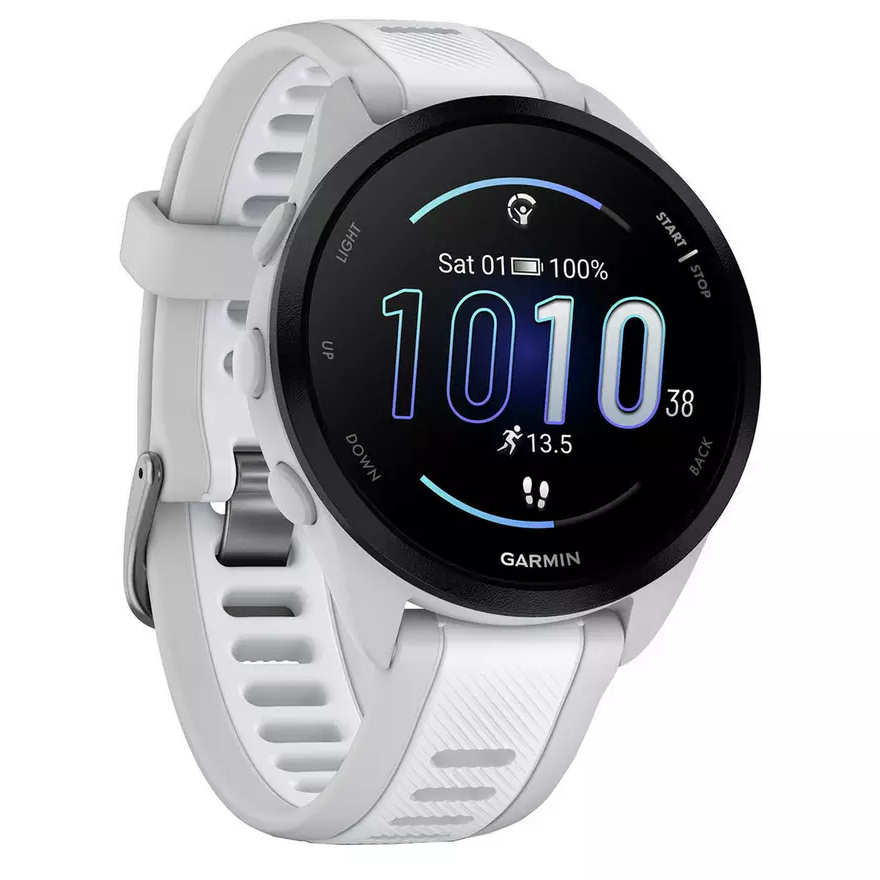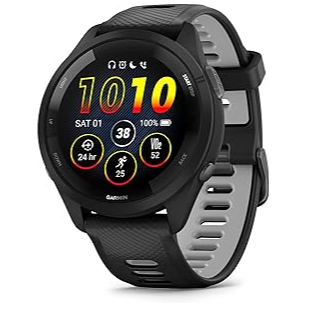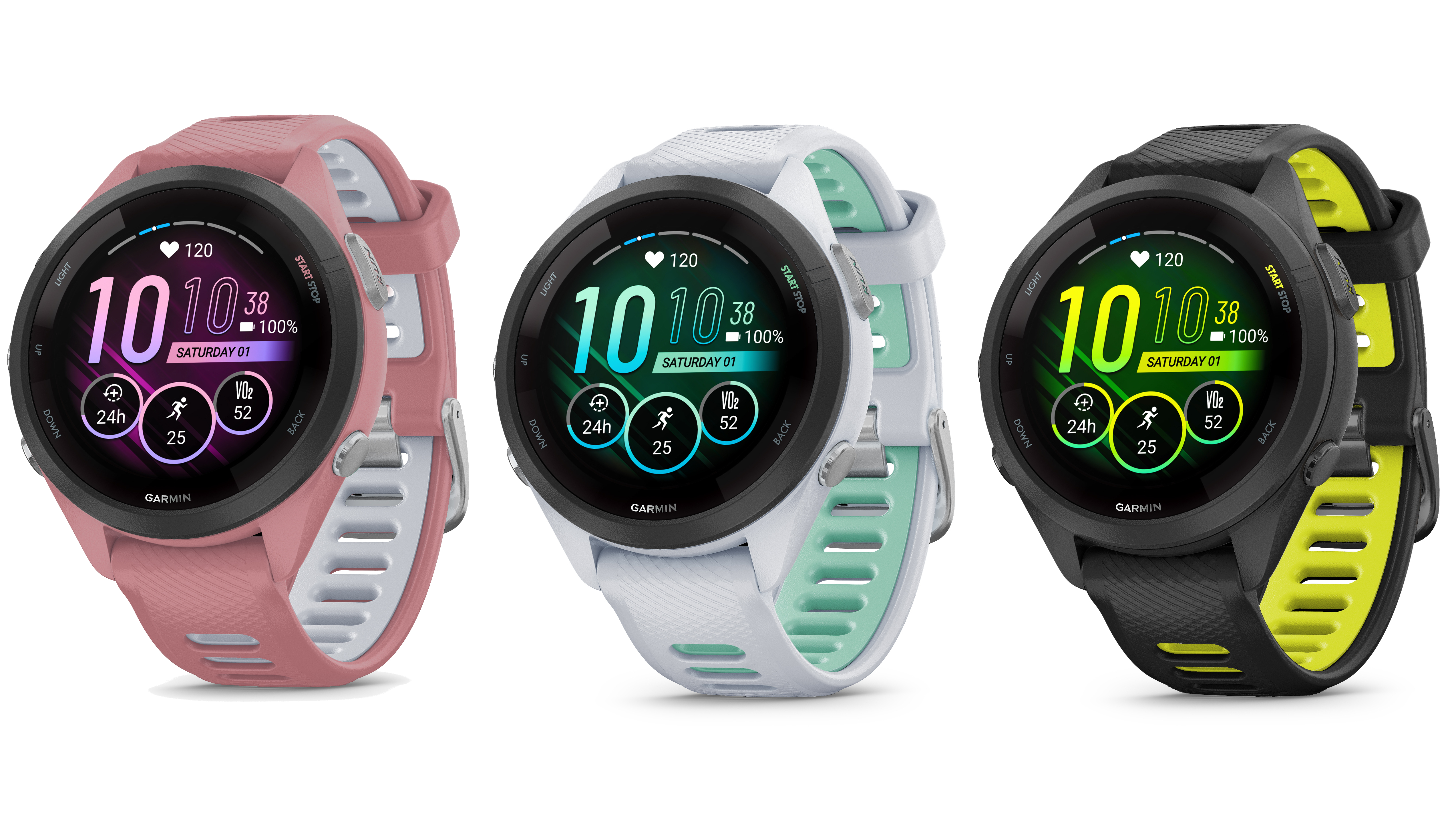
The Forerunner 165 is a great choice for beginners that's easy on your wallet and looks great. It covers all the essentials for new runners, even if you enjoy some cycling and swimming on the side. You can choose the basic version to save cash, or pay $50 extra for the version with music storage and playback.
Pros
- Much lower price
- Available with or without music
- Better for small wrists
Cons
- No sleep coaching
- No triathlon mode
- Fewer activity tracking modes
- Lacks Garmin SatIQ

If you're ready to take your running to the level level, training for a marathon or a challenging half marathon/10k time, the Forerunner 265 has tools to help you stick to a more advanced training plan. It's also the best choice if you're diving into the world of triathlons thanks to its dedicated multi-sports mode.
Pros
- Many more activity modes
- Longer battery life
- Larger display
- Multi-sports mode
Cons
- More expensive
The Garmin Forerunner 165 and Forerunner 265 are both excellent GPS watches, with bright AMOLED displays, advanced workout and recovery tracking tools, and lightweight and comfortable designs. However, there are some important differences between the two.
If you're looking for your first running watch, the Forerunner 165 would be a great option. It's significantly cheaper than the Forerunner 265 but still covers all the essentials, and even throws in some features you might not expect to find on such an affordable device such as the ability to upload and follow custom courses.
If you're starting to get serious about running (perhaps training for a marathon or aiming for am ambitious half marathon or 10k time) then the Forerunner 265 will be a better choice. It offers more advanced training tools for indoor and outdoor workouts, such as automatic interval training detection, support for smart trainers, and the ability to race against a virtual competitor.
The Forerunner 265 is also the better watch for triathletes, with a dedicated triathlon mode that means you can track an entire event as a single activity rather than having to end the activity and switch modes manually at each transition.
If you've made your choice already, you'll find today's best prices for both watches listed above. If not, read on for the full lowdown on both devices.
Design
- Both have AMOLED display
- Forerunner 265 is slightly larger
- Forerunner 265 has bigger screen
At first glance these two watches look very similar – both are lightweight, with a circular resin case, AMOLED display and silicone strap – but there are a few key differences. Firstly, the Forerunner 265 is slightly larger, measuring 46.1 x 12.9mm compared to 43 x 11.6mm for the Forerunner 165. The 265 also has a larger screen (32.5mm compared to 30.4mm). The difference is fairly subtle, but if you have slim wrists then you may find the smaller 165 more comfortable. If you want to see as much data on screen as possible, the 265 will suit you better.
Both watches come in a range of colors, and come with two-tone silicone bands. The bands for the Forerunner 265 have a contrasting shade on the inside, while those for the Forerunner 165 have a coordinating stripe down the center. Both watches take Garmin's standard 20mm quick release bands, and you can buy replacements in materials like leather and nylon separately.
All the latest inspiration, tips and guides to help you plan your next Advnture!

Battery life
- Forerunner 265 has longer battery life in smartwatch mode
- Battery life in GPS mode very similar for both watches
The Forerunner 165 has a maximum battery life of up to 11 days in smartwatch mode, and up to 19 hours in GPS-only mode, while the Forerunner 265 can run for up to 15 days in smartwatch mode, or 20 hours in GPS-only mode. Using the screen's always-on mode will reduce battery life significantly for either watch, but during testing I found that both do an excellent job detecting when you've raised your wrist to check the screen and activating it automatically, so I personally didn't find always-on necessary.
Both watches are charged using Garmin's proprietary USB-C cable, which plugs securely into the back of the watch.
Smartwatch features
- Standard Forerunner 165 doesn't have Wi-Fi or music
- Both watches have Garmin Pay
Both watches have Bluetooth and ANT+ connectivity, allowing you to connect them to external heart rate monitors and other devices (with some exceptions; more on that shortly) but the standard Forerunner 165 doesn't have Wi-Fi. That's not a huge drawback, but you'll find that apps and software updates take longer to download because they'll have to be transferred from your phone via Bluetooth.
The standard Forerunner 165 doesn't offer music storage and playback either, so you can't use it to listen to your favorite tunes without carrying your phone. If that feature is important to you, you'll need to upgrade to the Forerunner 165 Music, which costs $50/£30 more. The Forerunner 265 has music storage and playback as standard.
Otherwise, the two watches are very similar in terms of everyday smartwatch features, with tools including Garmin Pay for contactless purchases, alarms, and find my watch/phone.

Sports tracking
- Forerunner 265 has triathlon mode and more activities
- Forerunner 265 has Garmin SatIQ
- Forerunner 265 has more advanced run training tools
Both the Forerunner 265 and 165 are great for beginner and mid-level runners, but the 265 has more sports tracking modes, including (most significantly) a triathlon mode that allows you to record a whole multi-sport event in one go, rather than tracking each stage individually.
The Forerunner 265 is also the better choice if you enjoy an adventure. It supports skiing, snowshoeing and snowboarding, various water sports like SUP and kayaking; hiking; trail and ultra running; mountain biking and many more sports that take you off the beaten track.
If you regularly train on an indoor bike, it's also worth knowing the only the Forerunner 265 can be used to control and follow workouts on a smart trainer. The 265 is also the only one that can be used to control a Virb action camera.
Only the 265 has on-screen animated workouts for activities like yoga and pilates, as well as Muscle Map graphics that show which muscle groups you've been working recently to help you balance your training,
That said, the Forerunner 165 is still an excellent watch for recreational runners, cyclists and swimmers, and although it's marketed as an entry-level watch, it doesn't have the same limitations as the Forerunner 55 that preceded it. For example, the 165 allows you to import courses created within the Garmin Connect app or GPX files made using a third-party tool, which you can then follow on your wrist. This is a feature that's absent from the Forerunner 55, and makes a big difference when you want to explore somewhere new.
Both watches support GPS, Galileo, and GLONASS satellite navigation systems, but only the 265 has SatIQ, which determines the best GPS mode depending on your environment, and in my experience, GPS tracking on the Forerunner 265 is more accurate than the 165. During my tests, the Forerunner 165 has consistently under-reported the distance run. The difference isn't huge, but it's amplified over longer distances, so it you're working up to a marathon then the 265 may be a better option.
The 265 is also better equipped for interval training. Although both watches can track intervals, the 265 benefits from features like automatic interval detection, a dedicated intervals data page, and a rest screen. Other advanced training tools include the ability to race against a virtual partner, or against one of your own previous workouts.
- The best cheap GPS watches: our top recommendations tested and rated

Cat is the editor of Advnture, She’s been a journalist for 15 years, and was fitness and wellbeing editor on TechRadar before joining the Advnture team in 2022. She’s a UK Athletics qualified run leader, and in her spare time enjoys nothing more than lacing up her shoes and hitting the roads and trails (the muddier, the better), usually wearing at least two sports watches.
